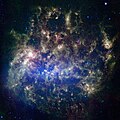Податотека:Magellanic Cloud.jpg

Големина на овој преглед: 600 × 600 пиксели. Други разделности: 240 × 240 пиксели | 480 × 480 пиксели | 768 × 768 пиксели | 1.024 × 1.024 пиксели | 2.048 × 2.048 пиксели | 13.250 × 13.250 пиксели.
Изворна податотека (13.250 × 13.250 пиксели, големина: 58,1 МБ, MIME-тип: image/jpeg)
Историја на податотеката
Стиснете на датум/време за да ја видите податотеката како изгледала тогаш.
| Датум/време | Минијатура | Димензии | Корисник | Коментар | |
|---|---|---|---|---|---|
| тековна | 11:49, 28 декември 2011 |  | 13.250 × 13.250 (58,1 МБ) | Prof. Professorson | Highest resolution, from http://www.spitzer.caltech.edu/images/1670-ssc2006-17b1-Large-Magellanic-Cloud-in-the-Infrared (http://www.spitzer.caltech.edu/uploaded_files/images/0006/2139/ssc2006-17b1.jpg). |
| 11:20, 28 декември 2011 |  | 6.000 × 6.000 (7,32 МБ) | Bulwersator | full image (from source) | |
| 11:14, 28 декември 2011 |  | 516 × 387 (63 КБ) | Bulwersator | Transferred from en.wikipedia: see original upload log above |
Употреба на податотеката
Податотекава се користи во следнава страница:
Глобална употреба на податотеката
Оваа податотека ја користат и следниве викија:
- Употреба на en.wikipedia.org
- Употреба на id.wikipedia.org
- Употреба на it.wikibooks.org
- Употреба на simple.wikipedia.org
- Употреба на vi.wikipedia.org

